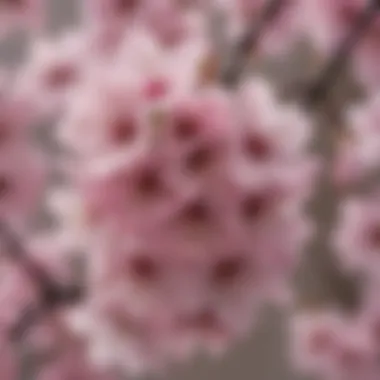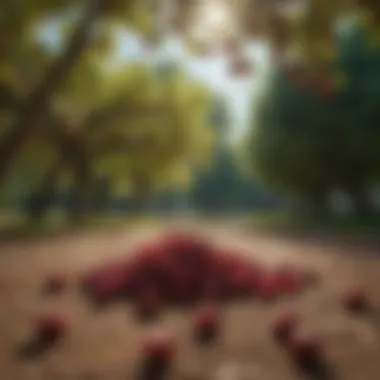Exploring Self-Fertilizing Cherry Trees for Home Gardens


Intro
Self-fertilizing cherry trees present an intriguing dimension in the realm of horticulture. These remarkable trees hold the unique ability to produce cherries without the necessity for cross-pollination, setting them apart from many other fruit-bearing trees. For both novice gardeners and seasoned horticulturists, understanding the nuances of these trees is vital—especially in urban environments where space can be tight.
In this guide, we will explore the genetic makeup and cultivation techniques that make self-fertilizing cherry trees a versatile choice for anyone looking to enhance their garden. Additionally, we'll cover the environmental conditions essential for their growth and the myriad benefits they offer.
This journey into the world of self-fertilizing cherry trees will unfold in several sections:
- Unique characteristics that set them apart
- Care requirements and cultivation best practices
- Environmental needs for optimum growth
- Benefits for urban gardening and small spaces
- Biological insights that underpin their self-fertilizing abilities
By the end of this article, you will have a comprehensive understanding of self-fertilizing cherry trees, empowering you with the knowledge to boost your gardening experience effectively.
Foreword to Self-Fertilizing Cherry Trees
Self-fertilizing cherry trees hold a special place in horticulture, particularly as urban gardening gains traction. These trees remove the traditional barriers of needing multiple trees for cross-pollination, making them a game changer for gardeners with limited space. For anyone looking to maximize fruit yield in small areas, the self-fertilizing nature of these cherry trees offers both convenience and abundance.
Definition and Characteristics
A self-fertilizing cherry tree essentially possesses the ability to produce fruit with its own pollen. This is a significant trait since it simplifies the gardening process. Knowing that just one tree can yield cherries no matter if another tree is around eliminates some common worries for novice gardeners.
These trees usually belong to specific genetic cultivars that have evolved to be more adaptable, allowing them to thrive in various climates and soil types. The key is that they contain both male and female reproductive organs in their flowers. This autonomy encourages urban and suburban dwellers to cultivate these delightful fruit-bearing plants more easily. With the right conditions, you could see fruit develop in a single growing season.
Characteristics of Self-Fertilizing Cherry Trees:
- Genetic Variation: Many cultivars are hybrids.
- Flower Structure: Flowers designed to facilitate self-pollination.
- Fruit Quality: Depending on the cultivar, fruit can be sweet or tart.
Historical Context and Evolution
Understanding the historical context behind self-fertilizing cherry trees adds a layer of appreciation for these robust plants. Historically, cherries have been grown for thousands of years. However, the introduction of self-fertilizing varieties is a more recent phenomenon. This evolution comes from the need for greater efficiency and adaptability in horticultural practices.
Gardeners and researchers sought ways to improve fruit yield even in challenging environments. This led to the development of self-fertilizing varieties, particularly notable in the 20th century when agricultural science made significant advances.
Originally, farmers relied on multiple trees to ensure cross-pollination. This often wasn’t feasible for everyone. Self-fertilizing cherry trees emerged as a solution, making it simpler for urban gardeners to enjoy cherries without requiring extensive knowledge of plant biology or environmental factors.
Overall, the evolution of these trees reflects a broader agricultural trend toward sustainability and ease of use. It allows families, urban gardeners, and horticultural enthusiasts to cultivate delicious fruit while reducing their ecological footprint.
Botanical Features
Understanding the botanical features of self-fertilizing cherry trees is essential for anyone looking to grow these remarkable plants. These trees showcase unique characteristics that not only allow them to thrive in various environments but also make them appealing for urban gardening enthusiasts. With their specific traits, such as genetic composition and reproductive strategies, they pave the way for effective cultivation and sustainable practices.
Genetic Makeup and Reproductive Strategy
The genetic makeup of self-fertilizing cherry trees is quite fascinating. Unlike their cross-pollinating counterparts, these trees possess the ability to produce fruit from a single tree. This trait arises from their unique genetic composition, often featuring a structure known as homomorphic self-incompatibility. Such genetic factors enable self-pollination, which reduces reliance on external pollinators.
Consider the Stella Cherry or the Compact Stella, both great examples of this genetic adaptation. They produce viable pollen and ovules that facilitate the fusion of gametes within the same flower. Consequently, this leads to fruit formation without needing another tree in proximity. It’s like having an ace up your sleeve in the gardening world where every bloom counts.
This reproductive strategy plays a pivotal role in ensuring consistent fruit production. For home gardeners or even small-scale farmers, the ability to grow fruit with just one tree can be a game changer. It not only simplifies planting arrangements but also offers a reliable yield, even in limited spaces.
Flowering Patterns


Flowering patterns in self-fertilizing cherry trees are another noteworthy aspect of their botanical features. These trees generally bloom in the spring, adorned with clusters of delicate pink and white flowers that are hard to miss. The timing and nature of their blooming can vary based on several factors, including species and local climate conditions.
What truly sets them apart is their ability to flower in a way that maximizes pollination efficiency without requiring multiple plants. For instance, the Lapins Cherry, recognized for its self-fertilizing capabilities, produces flowers that are hermaphroditic. This means each flower has both male and female reproductive organs, allowing it to pollinate itself more efficiently.
Furthermore, the flowering period can influence fruit quality and yield. Trees that bloom in warmer climates or regions with extended growing seasons tend to develop more flavorful fruits than those struggling in cooler conditions.
In summary, understanding the genetic makeup and flowering patterns of self-fertilizing cherry trees offers valuable insights not only into their cultivation but also into the broader ecosystem where these trees thrive. With their unique reproductive strategies and flowering tendencies, these trees are poised to play a significant role in sustainable gardening practices, especially for those limited by space and resources.
By appreciating these botanical features, gardeners can cultivate a stronger connection with nature, enhancing both their gardens and their understanding of ecological dynamics.
To dive even deeper into the botanical wonders of cherry trees, check resources like Wikipedia or Britannica.
Understanding these features not only enhances horticultural skills but also enriches one's experience as a gardener.
Cultivation Practices
Cultivating self-fertilizing cherry trees is a rewarding endeavor, particularly for those with limited space. These trees not only provide a bounty of fruit but also require careful attention during their growth cycle. Understanding the essential elements of cultivation practices helps ensure strong, healthy trees that produce abundant cherries.
Soil and Nutrient Requirements
The foundation of any successful gardening venture lies in the soil. The same holds true for self-fertilizing cherry trees. Ideally, the soil should be well-drained, rich in organic matter, and have a slightly acidic to neutral pH level, ideally between 6.0 and 7.0. It's good practice to conduct a soil test prior to planting. This will help determine nutrient levels and inform amendments needed for optimal growth.
Utilizing compost can help a great deal. Mixing in compost not only enriches your soil but improves its structure, allowing for better water retention and aeration. Consider using slow-release fertilizers high in potassium and phosphorus, which are essential for flowering and fruit set. Regularly adding organic mulch around the base of the tree also aids moisture retention while suppressing weeds that vie for nutrients.
"Providing appropriate soil conditions can be the difference between bountiful harvests and fruitless branches."
Watering and Irrigation Techniques
Watering self-fertilizing cherry trees strikes a delicate balance. While these trees are relatively drought-tolerant, especially once established, consistent moisture is paramount during the early stages of growth and especially during the fruiting period. A deep watering approach is preferable, rather than frequent shallow watering. This encourages the roots to grow deep into the moisture layer.
For those with larger cultivation areas, setting up a drip irrigation system can save time and ensure even moisture distribution. If you go the traditional route with a hose or watering can, aim to water early in the morning to minimize evaporation losses. During dry spells, aim to provide about one inch of water per week, adjusting upward during dry spells or when cherries are forming.
Pruning and Maintenance
Regular pruning is essential to enable self-fertilizing cherry trees to reach their full potential. This not only nurtures their shape but also promotes airflow and sunlight penetration, reducing the risks of fungal diseases. Begin pruning during dormancy in late winter or early spring before buds begin to swell. Focus on removing any dead, damaged, or crossing limbs and thinning out dense areas to allow for light access.
Maintaining general hygiene around the tree can’t be overstated. Raking up fallen leaves and debris during the growing season helps deter pests and diseases. Periodic inspection for pests such as aphids or cherry fruit flies should be conducted actively, employing organic or chemical means as necessary.
Proper cultivation practices not only support tree health but also enhance fruit quality and yield. The commitment to care and careful attention to nurturing these trees can yield fruits not just of labor, but of satisfying flavors and community enjoyment.
Environmental Considerations
Understanding environmental considerations is crucial for anyone looking to cultivate self-fertilizing cherry trees. These trees, while advantageous for their unique pollination capabilities, still require specific environmental conditions to thrive. Addressing these elements can significantly enhance both growth and fruit yield, which is vital for urban gardeners and those with limited space.
Climate Preferences
Self-fertilizing cherry trees typically flourish in temperate climates. They need a reassuring balance of warmth coupled with a cool period during winter to induce dormancy, which is essential for their health. Most varieties prefer temperatures ranging between 70°F to 75°F during the growing season. Here are a few key climate preferences:
- Sunlight: These trees love sunlight. A location receiving full sun—around six to eight hours of direct sunlight a day—will help them produce more flowers and ultimately more fruit.
- Temperature Range: Ideal growing temperatures sit between 60°F and 75°F. Winter chill hours, where the temperature dips below 45°F, are vital. Some varieties need up to 1,000 chill hours for optimal fruiting.
- Humidity Levels: Moderate humidity is preferred. Too much moisture invites rot, while too little can stress the plant. A good rule of thumb is to aim for humidity around 50% to 70% during the growing season.
Taking these factors into account is essential for ensuring these trees not only survive but also thrive in your garden.


Pest and Disease Management
Keeping a keen eye on pests and diseases is vital in any gardening endeavor, particularly when it comes to self-fertilizing cherry trees.
Common Pests
- Cherry Fruit Flies: They can make a meal out of your fruit, so vigilance is important. Set traps during the fruiting season to monitor their activity.
- Aphids: These tiny pests can sap your plant's strength. They often appear in clusters on new growth and can create a sticky mess. Regular inspection can help catch these little nuisances early.
Diseases to Watch Out For
- Brown Rot: This is a fungal disease that often appears in warm, humid conditions. It can lead to fruit decay, so good air circulation and proper spacing of trees is key.
- Powdery Mildew: This disease is typically a sign of overcrowding or poor air circulation, manifesting as a white powdery substance on leaves and stems. Early intervention is the best course—consider fungicides or organic options if needed.
"Healthy trees are both happy and productive! Simple practices can help keep them that way."
To keep pests and diseases at bay, integrate robust management practices, such as monitoring weather patterns and staying informed about local pest outbreaks. Additionally, consider organic methods like introducing beneficial insects or using neem oil as a natural pesticide. Regular maintenance not only ensures a healthy tree but also promises a bountiful harvest.
Benefits of Self-Fertilizing Cherry Trees
Self-fertilizing cherry trees offer numerous advantages, making them a key consideration for anyone looking to enhance their gardening experience. As urban gardening becomes increasingly sought after, the relevance of self-fertilizing trees grows ever more prominent. One critical benefit is their ability to thrive in limited spaces, appealing not only to horticulturists but also to families who want to enjoy fresh fruits without requiring extensive outdoor areas.
Space Efficiency in Urban Settings
Urban environments often come with their own set of challenges when it comes to gardening. Small backyards, balconies, or even patio spaces can feel restrictive. In these compact areas, the self-fertilizing cherry tree shines.
- No Need for Multiple Trees: Unlike traditional cherry varieties, which often need a companion tree for cross-pollination, self-fertilizing types can produce fruit all on their own. A single tree can yield a bountiful harvest, making it perfect for urban gardeners who lack space to plant multiple trees.
- Dense Vertical Growth: Many self-fertilizing cherry trees are bred to grow upwards rather than outwards. This means that you can plant them next to walls or in corners without sacrificing valuable ground space.
- Container Gardening: These cherry trees can also adapt well to container life. By choosing the right dwarf or compact varieties, families can grow them on balconies or even indoors, bringing the joy of home-gardening into their daily lives.
As you can see, the space efficiency of these trees not only promotes gardening where it might otherwise be impossible but also caters to the current landscape of urban living.
Increased Fruit Production
The potential for increased fruit production is perhaps the icing on the cake when discussing self-fertilizing cherry trees. The advantages they offer in terms of yield are significant:
- Consistent Yield: Unlike some fruit trees which can yield sporadically, self-fertilizing cherries provide a more reliable harvest each season. This stability can be particularly appealing for families eager to enjoy fresh cherries regularly.
- Improved Pollination: Self-fertilizing varieties often have more effective pollen and stigma interactions, leading to better fruit set. This means that even in less-than-ideal conditions, such as limited access to pollinators, these trees can still perform admirably.
- Extended Harvest Period: Depending on the variety, self-fertilizing cherries can extend the harvesting period. This means that families can enjoy cherries for a longer time, making them not only a delightful treat but also a rewarding gardening investment.
In summary, self-fertilizing cherry trees present a double-edged sword of benefits: their space-efficient nature makes them ideal for urban environments while their enhanced fruit production appeals to those craving home-grown produce. Each of these traits adds to their allure, making them worthy of consideration for any horticultural venture.
Culinary Uses of Cherry Fruits
The culinary uses of cherry fruits extend far beyond simply enjoying them fresh off the tree. In many ways, these distinct fruits embody a range of flavors and textures, bringing a delightful burst of taste to various dishes and drinks. Understanding how to leverage their unique properties can enrich the culinary landscape, benefiting anyone from professional chefs to home cooks.
Nutritional Value and Health Benefits
Cherries, in particular the self-fertilizing varieties, pack a powerful nutritional punch. To start, these small yet vibrant fruits are rich in vitamins such as vitamin C, which is essential for maintaining a healthy immune system, and vitamin A, which aids in vision health. Additionally, they contain significant amounts of potassium, promoting heart health and regulating blood pressure.
Beyond mere vitamins, cherries are also renowned for their antioxidant properties. One compound, anthocyanin, gives cherries their distinctive red hue and has been linked to a variety of health benefits such as improved heart health and reduced inflammation. Regular consumption may help in managing conditions such as arthritis or gout, although it’s always wise to consult with a healthcare provider.
Moreover, these fruits are low in calories, making them an excellent choice for those watching their weight while still desiring a sweet treat. In fact, a cup of pitted cherries counts for a mere 97 calories, providing a guilt-free option for satisfying dessert cravings.
Culinary Applications: From Fresh to Processed


Cherries lend themselves beautifully to a wide array of culinary applications, transcending the realm of fresh consumption. Here are some versatile ways to maximize your use of self-fertilizing cherry fruits in the kitchen:
- Fresh Consumption: Fresh cherries are perfect as a snack, but they shine in salads. Toss them in a green salad for a sweet contrast to peppery arugula, or combine them with nuts for added texture.
- Desserts: Cherry pies are perhaps one of the most iconic desserts featuring this fruit, with their tangy-sweet filling nestled in a flaky crust. Other favorites include tart cherry tarts and cobblers, which evoke warm, nostalgic feelings while being relatively easy to make.
- Beverages: Cherries can be transformed into refreshing juices, smoothies, or even cocktails. Cherry juice has gained traction for its health benefits and can be a delightful component in various drinks.
- Preserves and Sauces: Preserving cherries by canning or making jams allows one to enjoy their flavor year-round. A cherry sauce can also enhance savory dishes, particularly with meats like duck or pork, offering a balancing sweetness.
- Baking: Beyond pies, cherries can be incorporated into muffins, breads, and scones, infusing baked goods with vibrant color and flavor.
"Cherries, whether consumed fresh, cooked, or preserved, create a delightful culinary experience that showcases their versatility."
Utilizing self-fertilizing cherry trees can really make the most of garden space. After all, fewer trees mean less pruning and maintenance, but even more cherries to enjoy in all forms. So whether you're crafting a tart for a warm summer's evening or a refreshing smoothie to kickstart your day, the possibilities really are endless with cherry fruits.
Challenges in Cultivating Self-Fertilizing Cherry Trees
Growing self-fertilizing cherry trees can seem like a walk in the park, but there are challenges that might trip up even the best of gardeners. Understanding these hurdles is crucial for maximizing the yield and health of these trees. We'll consider misconceptions, limitations, and ways to counter these issues to ensure a fruitful cultivation experience.
Common Misconceptions
Many folks often believe that self-fertilizing cherry trees don't require any other trees for pollination, which is true. However, this perception can lead to a lack of awareness about other vital care aspects. People might think that once they plant a self-fertilizing tree, they can just sit back and relax. Unfortunately, that mindset can spell trouble.
For example, some cherry varieties that are labeled as self-fertilizing may produce better fruit yields when another cherry tree is nearby, even if it's not the same variety. Moreover, the term "self-fertilizing" can be a bit misleading. It doesn’t mean every flower will turn into fruit without an external nudge. Factors like weather, pollinator activity, and tree health still play pivotal roles in ensuring good production.
It's also commonly believed that self-fertilizing varieties are more resilient to diseases and pests compared to other types. This is a misconception that can result in gardeners neglecting proper pest management strategies, potentially exposing their trees to infestations. Regular monitoring and appropriate preventative measures are necessary, despite the perceived advantages of self-fertilized species.
Limitations of Self-Fertilization
While the ability of self-fertilizing cherry trees to produce fruit independently is advantageous, there are limitations to this process that gardeners should keep in mind. The reproductive success of a given tree can heavily rely on its genetic background. Some trees may produce fruit, but the overall quality can vary significantly. This inconsistency may leave one disappointed after investing time and care into their beloved plants.
The genetic diversity within a population can also influence growth rates and disease resistance. Trees that exclusively self-pollinate may miss out on the benefits of genetic variation, which can result in weaker fruit quality over time. Furthermore, self-fertilization could lead to inbreeding, which is not just a concern in animals; it can reduce vigor in plants too.
Here are a few limitations to keep in mind:
- Reduced genetic variation: This can make trees more susceptible to diseases.
- Inconsistent fruit quality: Despite producing fruit, the taste and size may vary.
- Vulnerability to environmental stress: Trees relying solely on self-fertilization may not cope as well with climate fluctuations.
Ultimately, understanding these challenges equips gardeners with the tools for better care practices, paving the way for fruitful experiences while cultivating self-fertilizing cherry trees. By addressing common misconceptions and recognizing the limitations inherent to these trees, one can adopt a more nuanced approach to nurturing and enjoying their benefits.
Closure
The realm of self-fertilizing cherry trees offers much more than just an opportunity for home gardeners and horticultural enthusiasts to indulge in a bit of green-thumb magic. These trees exemplify innovation in nature, showing how some flora have adapted to thrive without reliance on others for reproductive success. Understanding the future of these varieties, as well as encouraging sustainable gardening practices, is essential not only for maximizing fruit production but also for paving a path toward a more eco-conscious approach in gardening.
Future of Self-Fertilizing Varieties
The potential for self-fertilizing cherry varieties is vast and worth exploring. As we face climate change challenges, the adaptability of these trees makes them a critical player in resilient gardening. Breeders are continuously working to enhance traits like disease resistance and fruit quality. This ongoing improvement can lead to cultivars with shorter maturation rates, which will benefit those in colder climates who might otherwise miss their window for a fruitful harvest. Additionally, research into the genetic makeup of these trees could enable the engineering of more efficient self-pollination traits. As horticulturists delve deeper into plant genetics, it’s likely we’ll see varieties that yield more fruit with less effort, potentially transforming urban landscapes into fruitful gardens even further.
- Diversifier characteristics include:
- Enhanced flavor profiles
- Resistance to local pests
- Adaptability to various soil types
The economic aspect of this remains significant. As urban gardening gains traction, self-fertilizing cherry trees present a practical option for individuals with limited space. Cultivating these trees involves minimal inputs, offering a rewarding return in terms of fruit production, which can significantly benefit households and communities alike.
Encouraging Sustainable Gardening Practices
Sustainable practices in gardening are crucial, especially as urban areas become increasingly crowded, and green spaces shrink. Promoting these practices when cultivating self-fertilizing cherry trees not only supports biodiversity but helps in maintaining a balanced ecosystem. A few ways to enhance sustainability in gardening with these trees include:
- Companion planting: By pairing cherry trees with compatible plants, gardeners can improve pest control and enhance soil health. For instance, planting herbs like basil can naturally deter pests.
- Organic fertilizers and pesticides: Prioritizing eco-friendly options prevents harm to beneficial insects and contributes to a healthier growing environment.
- Crop rotation: Even with self-fertilizing varieties, rotating the planting location year by year can maintain soil fertility and reduce the likelihood of disease.
By adopting sustainable gardening habits, not only will you enhance the productivity of self-fertilizing cherry trees, but you’ll also contribute positively to the ecosystem around you. This holistic approach to gardening promotes health and well-being, encouraging all of us to think bigger—about the trees we cultivate, the fruits we reap, and our role in fostering a more sustainable future.
"Gardening is the purest of human pleasures." — Francis Bacon
In summary, as we look to the future, understanding the complexities and potential of self-fertilizing cherry trees could open wide doors for innovation in both gardening techniques and community agriculture. The spectrum of benefits— from providing fresh produce in limited spaces to enhancing environmental health— underscores their significance in the modern gardening landscape.







